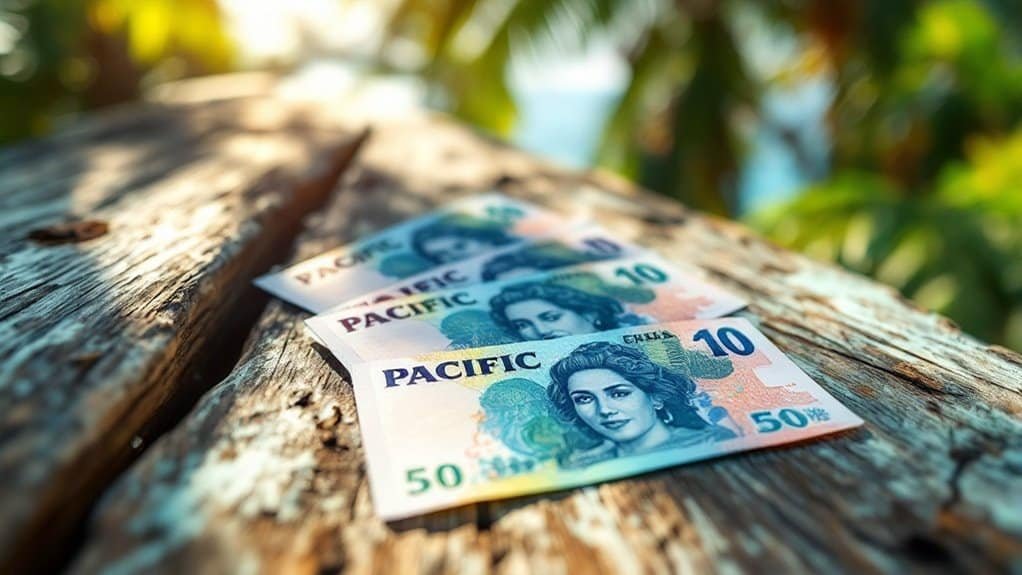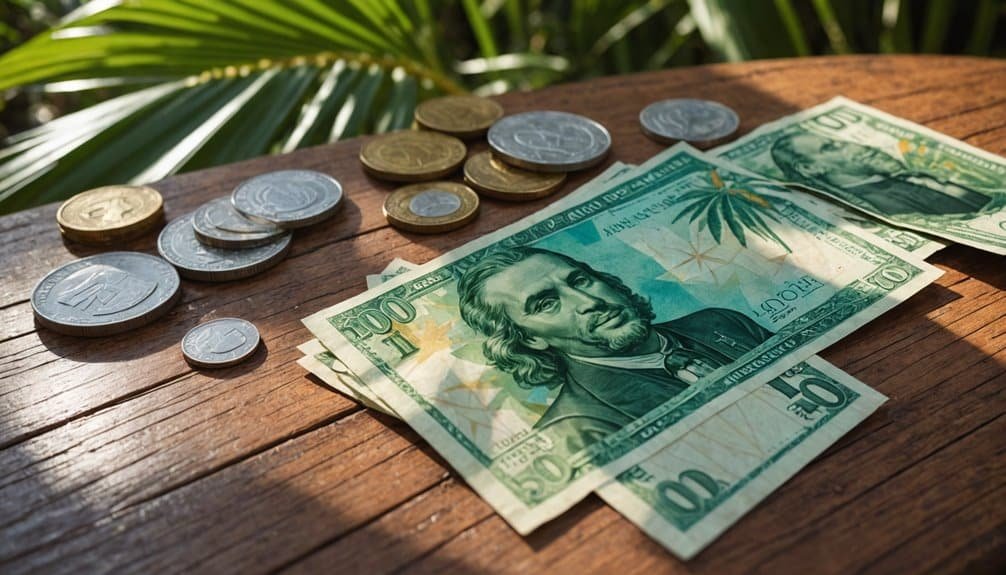
The CFP Franc (XPF) serves as French Polynesia's official currency, fixed at 119.3317 to the Euro and backed by the French government. You'll encounter this currency across Tahiti and surrounding islands, with denominations ranging from F 500 to F 10,000. Credit card payments work in urban areas, but cash remains essential in remote locations. Exchange services are available at Tahiti-Faa'a International Airport and local banks, accepting major currencies like USD and EUR. ATMs provide convenient cash access on primary islands. The currency reflects a complex economic landscape driven by tourism and black pearl industries, with a stable monetary policy maintaining an inflation rate around 1.7936%. Unraveling its intricacies reveals deeper economic narratives.
Key Takeaways
- The CFP Franc is a stable currency fixed to the Euro at 119.3317, backed by the French government and used in French Polynesia.
- Currency transactions in Tahiti vary between urban and remote areas, with credit cards preferred in cities and cash essential in smaller locations.
- Travelers can exchange money at Tahiti-Faa'a International Airport, local banks in Pape'ete, and ATMs, accepting multiple currencies like USD, Euros, and AUD.
- The Pacific Franc reflects a diverse economic landscape driven by tourism, black pearl exports, and strategic monetary policies managed by Institut d'émission d'Outre-Mer.
- Effective money management in Tahiti involves carrying a mix of cash and cards, understanding exchange rates, and planning for varying payment acceptance across different regions.
What Makes the CFP Franc Unique
In the vast landscape of global currencies, the CFP Franc stands out as a distinctive monetary instrument with unique characteristics. Its currency features are defined by a fixed exchange rate with the Euro at 119.3317, guaranteeing stability through French government backing. Historical currency management has been a critical component of the CFP Franc's long-term economic strategy since its creation in 1945, ensuring consistent monetary stability across French Pacific territories.
Unlike many currencies, the XPF maintains a rigidly controlled valuation mechanism, reflecting its historical significance as a legacy of French colonial monetary policy.
You'll find the CFP Franc's distinctiveness in its precise regulatory framework, managed by the Institut d'émission d'Outre-Mer. Its circulation across French Pacific territories – including French Polynesia, New Caledonia, and Wallis and Futuna – demonstrates a specialized monetary approach.
The currency's structured denominations, from F 500 to F 10,000 banknotes, further underscore its tailored economic design, making it a fascinating study in specialized regional monetary systems.
Navigating Transactions in French Polynesia
Understanding the economic landscape of French Polynesia requires a systematic approach to monetary interactions. Your cash preferences will greatly influence transaction efficiency across the islands.
While credit cards dominate payments in urban centers like Tahiti, remote locations mandate cash transactions, necessitating strategic currency management. The airport exchange office provides convenient currency conversion services for incoming travelers.
ATM accessibility on primary islands enables convenient local currency procurement, with major banks providing reliable cash dispensers. MasterCard and Visa offer widespread payment methods, though prudent travelers should maintain cash reserves.
Local payment ecosystems demonstrate nuanced variability: supermarkets and hotels readily accept electronic payments, whereas markets and small shops exclusively transact in Pacific Francs (XPF).
Strategic financial preparation involves understanding these localized payment infrastructures, ensuring seamless monetary interactions throughout French Polynesian territories.
Currency Exchange and Local Tips

Nearly every traveler's financial strategy hinges on mastering currency exchange dynamics in French Polynesia. Your ideal exchange locations include Tahiti-Faa'a International Airport, with Banque Socredo and Banque de Tahiti offering convenient services for international arrivals and departures. CFP Franc fluctuations can significantly impact travelers' budgets, making real-time exchange rate monitoring crucial for financial planning.
Currency preferences center on US Dollars, Euros, Australian Dollars, and New Zealand Dollars, which can be exchanged at local banks in Pape'ete.
Be aware that some remote islands like Tuamotu, Gambier, and Austral lack exchange facilities, necessitating pre-trip financial planning.
Critical considerations include carrying small bills, understanding current exchange rates, and recognizing that while major credit cards are widely accepted, cash remains essential in smaller establishments.
ATMs are strategically positioned throughout main islands, providing additional financial flexibility for travelers traversing French Polynesia's diverse economic landscape.
Economic Impact and Monetary Challenges
The economic landscape of French Polynesia reveals a complex tapestry of challenges and opportunities, driven primarily by its strategic reliance on tourism and external financial support. Black cultured pearls, representing a significant export revenue stream, contribute substantially to the country's economic resilience.
Tourism contributions have been pivotal in maintaining economic stability, while inflation trends suggest a controlled economic environment.
Key economic dynamics include:
- Shift from military-driven revenue to diversified economic strategies
- Ongoing adaptation after nuclear testing facilities' closure in 1996
- Monetary policy adjustments through strategic interest rate modifications
- Maintaining economic resilience through targeted financial interventions
The Overseas Note-Issuing Institute's careful management of deposit facility rates and liquidity demonstrates a technical approach to economic stability.
With an inflation rate of 1.7936% in 2022, French Polynesia continues to navigate its complex economic terrain, balancing traditional resources, tourism, and strategic financial planning.
Practical Money Advice for Travelers

Currency Navigation in Tahiti demands strategic financial preparation. You'll want to prioritize budgeting tips that account for the region's unique monetary landscape.
Anticipate travel expenses by exchanging sufficient CFP Francs before departure, as ATM accessibility varies across islands. Carry a mix of local currency, credit cards, and limited USD or EUR for flexibility.
Expect minimum purchase requirements for credit card transactions and potential conversion surcharges. Strategic travelers recommend maintaining cash reserves for remote locations where electronic payments mightn't be feasible.
Calculate daily expenditures considering the exchange rate (1 USD ≈ 113.42 XPF), and factor in potential banking fees.
Proactively managing your financial resources guarantees smoother transactions and mitigates unexpected monetary challenges during your Tahitian exploration. French Polynesian territories primarily use the Pacific Franc, requiring travelers to be mindful of currency nuances across different islands.
Conclusion
If you're heading to Tahiti, remember that money talks, but local knowledge speaks volumes. You'll want to familiarize yourself with the CFP franc's nuances to navigate transactions smoothly. By understanding exchange rates, local economic dynamics, and strategic financial planning, you'll transform potential currency challenges into opportunities for a seamless, enriching Pacific island experience. Smart travelers adapt, and your fiscal preparedness will be your greatest travel asset.







Interesting read! But isnt it odd how the Pacific Franc isnt influenced by Tahitis local economy but by the Eurozones financial health?
Odd, yes, but isnt it also a sign of interconnected global economies?
Isnt it curious how the CFP Francs value is tied to the Euro? Makes you question the true independence of French Polynesias economy, doesnt it?